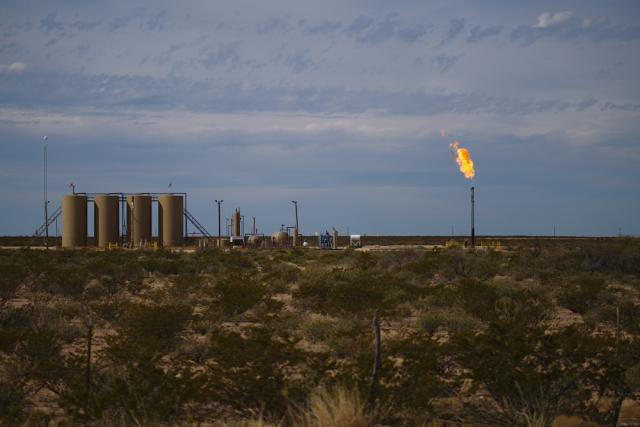
Burning excess natural gas at a crude oil storage site is a common practice when gas prices deem it uneconomical to transport the gas to market. (Source: Sean Hannon/Shutterstock.com)
New pipeline takeaway capacity online with more to come is expected to help operators reduce the amount of gas flared in the Permian Basin amid a push by some for tougher environmental controls.
Speaking during a recent energy conference, Pioneer Natural Resources Co. CEO Scott Sheffield briefly addressed emissions during a conversation with Goldman Sachs managing director Brian Singer that covered topics such as production and price forecasts, OPEC and U.S. shale behavior, consolidation, variable dividends and investor relations.
Pioneer, considered a leader among peers for having low emissions intensity rate, aims to eliminate routine flaring by 2025. Other companies, including Occidental Petroleum Corp., have also set ambitious targets to reduce greenhouse gas emissions.
Levels of flared gas have decreased in recent years in the Permian Basin as some companies have made emission reduction targets a priority, opting to use vapor recovery in operations, emissions monitoring technology to find leaks, and making sure infrastructure is in place before bringing a well online among other efforts. The recent slowdown in activity, driven by the coronavirus pandemic impacting demand, has also played a role.
“We’ve gone from 600 million a day flaring to 300 million a day,” Sheffield said of producers in the Permian Basin. “I think with these two new pipelines, it wouldn’t surprise me if we get to 150 million a day.”
The additional pipeline capacity from the Permian Highway Pipeline, Kinder Morgan Inc.’s $2 billion project that entered full service on Jan. 1, has given operators an alternative to burning or flaring associated gas that comes along with oil being targeted. Designed to transport up to 2.1 Bcf/d of natural gas, the 42-in. pipeline carries gas some 430 miles from the Waha, Texas, area to the U.S. Gulf Coast and Mexico markets.
Kinder Morgan also put into service in 2020 the Lockridge natural gas pipeline.
Plans are progressing for additional infrastructure, which could remove the lack of pipeline capacity being among the chief reasons for flaring in the Permian Basin. Pipelines scheduled to come online in 2021 include Stonepeak Infrastructure Partners’ 2 Bcf/d Whistler Pipeline, and WhiteWater Midstream LLC and MPLX LP’s 1.8 Bcf/d Agua Blanca pipeline system which connects nearly 20 gas processing sites in the Delaware Basin to the Waha Hub.
Still, more can be done to improve flaring rates, according to Sheffield.
“We got to have the commissions of both New Mexico and Texas really take charge and put out stricter guidelines,” he said. “We can only do so much.” He noted investors are also helping. They are pressuring companies to become more environmentally conscious by operating cleaner.
Texas regulators took steps toward flaring mitigation efforts in November when the Railroad Commission (RRC) approved changes to a data sheet. It requires companies seeking exception to flaring rules to more thoroughly document the need to flare gas and provide the RRC accurate information to assess compliance. Companies are required to use the new data sheet in April.
RELATED
- Coalition Gives Texas Oil Regulators Blueprint to Reducing Flaring
- Texas Railroad Commission Advances Flaring Regulation Efforts
- Midstream Projects and Construction: Live to Build Another Day
However, more controls could be in store if two bills introduced by Rep. Ron Reynolds in the Texas House eventually become law. HB 896 would require the Texas Commission on Environmental Quality (TCEQ) to devise rules to limit flaring and venting by oil and gas facilities, and HB 897 directs the TCEQ—working with the RRC—to find ways to improve safety and prevent emissions from oil and gas equipment and suggest incentives.
A Rystad Energy study on flaring in the Permian Basin found that:
- Flaring issues are not distributed evenly across the basin. Research covering a five-year period showed, for example, the worst-performing leases contributed 57% of all flaring but only 10% of gross gas production;
- At 56%, event-driven flares—such as midstream outages—are the most common; and
- Flaring intensity could rise above 3.5% if operators resume business-as-usual, surpassing 450 MMcf/d by 2025; however, the RRC’s revised form could lead to more flaring reductions, pushing flaring intensity to around 2.7%.
Rystad, which presented its study during a Baker Institute webinar in December, said it is possible for Permian operators to lower flaring intensity below 2%. Essential to achieving such level is “better collaboration upstream and midstream” with “a combination of better planning, investments and a realignment of incentives to remedy.”
Pioneer, which completed its acquisition of Parsley Energy Inc. on Jan. 12, said the company aims to limit its annual flaring intensity to less than 1%, including Parsley assets by year-end 2022.
Recommended Reading
BKV CEO Chris Kalnin says ‘Forgotten’ Barnett Ripe for Refracs
2024-04-02 - The Barnett Shale is “ripe for fracs” and offers opportunities to boost natural gas production to historic levels, BKV Corp. CEO and Founder Chris Kalnin said at the DUG GAS+ Conference and Expo.


